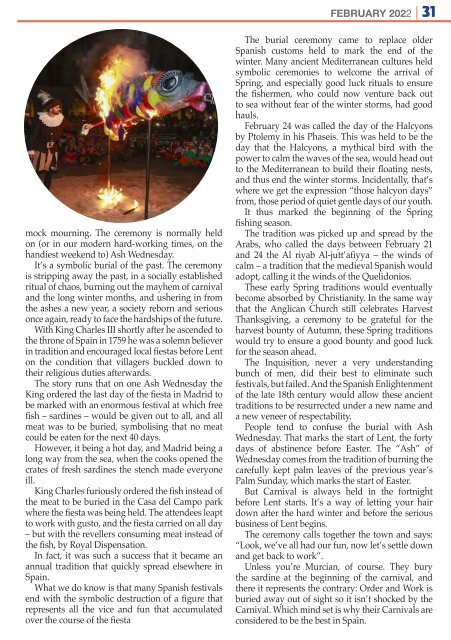Outandabout March 2022 Issue195
Welcome to March 2022 the Spring air has arrived and St Patrick's day will be celebrated again in Benidorm without restrictions. Tourism is already back to pre-covid numbers and the British holidaymakers who love Spain and the Costa Blanca are already on the beach and sunny terraces eating, drinking, and having lots of fun in the sun. The new Out and About magazine is right here to read and find out what's going on in the Costa Blanca region of Spain. Lifestyle and leisure articles and reviews are written by the people who know, business professionals, and members of the public living in Spain. There are also popular pages that include puzzles and horoscopes with a host of supporting businesses that supports the charity work that editor Carol Leavy has undertaken for many years in Spain.
Welcome to March 2022 the Spring air has arrived and St Patrick's day will be celebrated again in Benidorm without restrictions. Tourism is already back to pre-covid numbers and the British holidaymakers who love Spain and the Costa Blanca are already on the beach and sunny terraces eating, drinking, and having lots of fun in the sun. The new Out and About magazine is right here to read and find out what's going on in the Costa Blanca region of Spain. Lifestyle and leisure articles and reviews are written by the people who know, business professionals, and members of the public living in Spain. There are also popular pages that include puzzles and horoscopes with a host of supporting businesses that supports the charity work that editor Carol Leavy has undertaken for many years in Spain.
Create successful ePaper yourself
Turn your PDF publications into a flip-book with our unique Google optimized e-Paper software.
FEBRUARY <strong>2022</strong> | 31<br />
mock mourning. The ceremony is normally held<br />
on (or in our modern hard-working times, on the<br />
handiest weekend to) Ash Wednesday.<br />
It’s a symbolic burial of the past. The ceremony<br />
is stripping away the past, in a socially established<br />
ritual of chaos, burning out the mayhem of carnival<br />
and the long winter months, and ushering in from<br />
the ashes a new year, a society reborn and serious<br />
once again, ready to face the hardships of the future.<br />
With King Charles III shortly after he ascended to<br />
the throne of Spain in 1759 he was a solemn believer<br />
in tradition and encouraged local fiestas before Lent<br />
on the condition that villagers buckled down to<br />
their religious duties afterwards.<br />
The story runs that on one Ash Wednesday the<br />
King ordered the last day of the fiesta in Madrid to<br />
be marked with an enormous festival at which free<br />
fish – sardines – would be given out to all, and all<br />
meat was to be buried, symbolising that no meat<br />
could be eaten for the next 40 days.<br />
However, it being a hot day, and Madrid being a<br />
long way from the sea, when the cooks opened the<br />
crates of fresh sardines the stench made everyone<br />
ill.<br />
King Charles furiously ordered the fish instead of<br />
the meat to be buried in the Casa del Campo park<br />
where the fiesta was being held. The attendees leapt<br />
to work with gusto, and the fiesta carried on all day<br />
– but with the revellers consuming meat instead of<br />
the fish, by Royal Dispensation.<br />
In fact, it was such a success that it became an<br />
annual tradition that quickly spread elsewhere in<br />
Spain.<br />
What we do know is that many Spanish festivals<br />
end with the symbolic destruction of a figure that<br />
represents all the vice and fun that accumulated<br />
over the course of the fiesta<br />
The burial ceremony came to replace older<br />
Spanish customs held to mark the end of the<br />
winter. Many ancient Mediterranean cultures held<br />
symbolic ceremonies to welcome the arrival of<br />
Spring, and especially good luck rituals to ensure<br />
the fishermen, who could now venture back out<br />
to sea without fear of the winter storms, had good<br />
hauls.<br />
February 24 was called the day of the Halcyons<br />
by Ptolemy in his Phaseis. This was held to be the<br />
day that the Halcyons, a mythical bird with the<br />
power to calm the waves of the sea, would head out<br />
to the Mediterranean to build their floating nests,<br />
and thus end the winter storms. Incidentally, that’s<br />
where we get the expression “those halcyon days”<br />
from, those period of quiet gentle days of our youth.<br />
It thus marked the beginning of the Spring<br />
fishing season.<br />
The tradition was picked up and spread by the<br />
Arabs, who called the days between February 21<br />
and 24 the Al riyab Al-jutt’afiyya – the winds of<br />
calm – a tradition that the medieval Spanish would<br />
adopt, calling it the winds of the Quelidonios.<br />
These early Spring traditions would eventually<br />
become absorbed by Christianity. In the same way<br />
that the Anglican Church still celebrates Harvest<br />
Thanksgiving, a ceremony to be grateful for the<br />
harvest bounty of Autumn, these Spring traditions<br />
would try to ensure a good bounty and good luck<br />
for the season ahead.<br />
The Inquisition, never a very understanding<br />
bunch of men, did their best to eliminate such<br />
festivals, but failed. And the Spanish Enlightenment<br />
of the late 18th century would allow these ancient<br />
traditions to be resurrected under a new name and<br />
a new veneer of respectability.<br />
People tend to confuse the burial with Ash<br />
Wednesday. That marks the start of Lent, the forty<br />
days of abstinence before Easter. The “Ash” of<br />
Wednesday comes from the tradition of burning the<br />
carefully kept palm leaves of the previous year’s<br />
Palm Sunday, which marks the start of Easter.<br />
But Carnival is always held in the fortnight<br />
before Lent starts. It’s a way of letting your hair<br />
down after the hard winter and before the serious<br />
business of Lent begins.<br />
The ceremony calls together the town and says:<br />
“Look, we’ve all had our fun, now let’s settle down<br />
and get back to work”.<br />
Unless you’re Murcian, of course. They bury<br />
the sardine at the beginning of the carnival, and<br />
there it represents the contrary: Order and Work is<br />
buried away out of sight so it isn’t shocked by the<br />
Carnival. Which mind set is why their Carnivals are<br />
considered to be the best in Spain.

















